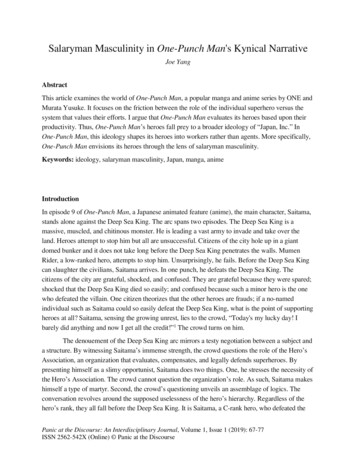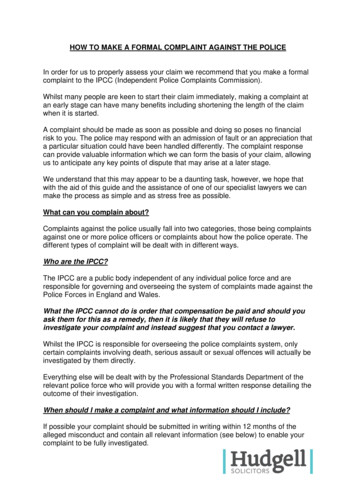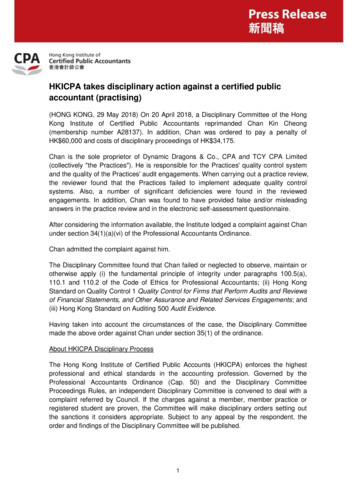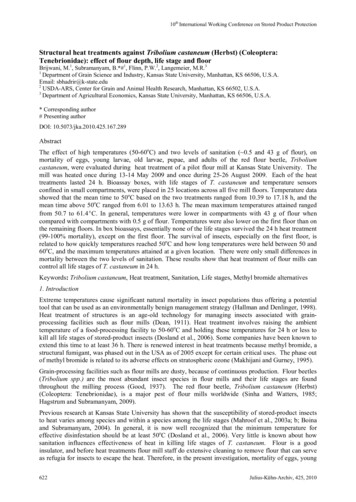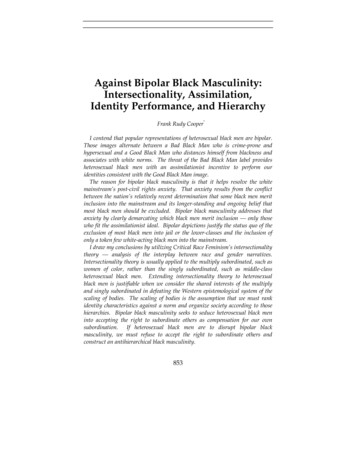
Transcription
Against Bipolar Black Masculinity:Intersectionality, Assimilation,Identity Performance, and Hierarchy*Frank Rudy CooperI contend that popular representations of heterosexual black men are bipolar.Those images alternate between a Bad Black Man who is crime-prone andhypersexual and a Good Black Man who distances himself from blackness andassociates with white norms. The threat of the Bad Black Man label providesheterosexual black men with an assimilationist incentive to perform ouridentities consistent with the Good Black Man image.The reason for bipolar black masculinity is that it helps resolve the whitemainstream’s post-civil rights anxiety. That anxiety results from the conflictbetween the nation’s relatively recent determination that some black men meritinclusion into the mainstream and its longer-standing and ongoing belief thatmost black men should be excluded. Bipolar black masculinity addresses thatanxiety by clearly demarcating which black men merit inclusion — only thosewho fit the assimilationist ideal. Bipolar depictions justify the status quo of theexclusion of most black men into jail or the lower-classes and the inclusion ofonly a token few white-acting black men into the mainstream.I draw my conclusions by utilizing Critical Race Feminism’s intersectionalitytheory — analysis of the interplay between race and gender narratives.Intersectionality theory is usually applied to the multiply subordinated, such aswomen of color, rather than the singly subordinated, such as middle-classheterosexual black men. Extending intersectionality theory to heterosexualblack men is justifiable when we consider the shared interests of the multiplyand singly subordinated in defeating the Western epistemological system of thescaling of bodies. The scaling of bodies is the assumption that we must rankidentity characteristics against a norm and organize society according to thosehierarchies. Bipolar black masculinity seeks to seduce heterosexual black meninto accepting the right to subordinate others as compensation for our ownsubordination. If heterosexual black men are to disrupt bipolar blackmasculinity, we must refuse to accept the right to subordinate others andconstruct an antihierarchical black masculinity.853
854University of California, Davis[Vol. 39:853TABLE OF CONTENTSINTRODUCTION. 855I. THEORETICAL FRAMEWORK: INTERSECTIONALITY THEORY ANDTHE SCALING OF BODIES . 860A. Intersectionality Theory . 863B. The Debate over Extending Intersectionality Theory to theSingly Subordinated. 8661. Symbiosis Theory. 8662. A Challenge to Extending Intersectionality Theory. 868C. The Scaling of Bodies . 870D. Conclusion . 873II. THE BIPOLAR IMAGES OF BLACK MASCULINITY . 874A. The Bad Black Man . 875B. The Good Black Man. 8791. Larry Mungin’s Story . 8802. Corporate Production of the Good Black Man . 8823. The Intersectionality of the Good Black Man Image. 885C. Conclusion: The Relationship Between the Bipolar Imagesand the Assimilationist Incentive . 886III. WHY THE IMAGES ARE BIPOLAR: POST-CIVIL RIGHTS ANXIETYAND THE STATUS QUO . 888A. Post-Civil Rights Anxiety. 888B. How Bipolar Images Justify the Status Quo . 8911. Containment of the Masses . 8912. The Assimilationist Incentive as False Inclusiveness. 893C. Conclusion . 895IV. THE HIDDEN EFFECT OF THE BIPOLARITY: THE SEDUCTION INTOHIERARCHY . 896A. Assimilation as Emulation of Normative White Men. 897B. Normative Masculinity as Domination . 898C. The Desire for Compensatory Subordination. 899D. Seduction into Accepting the Present Hierarchies. 902E. Conclusion: Against Bipolar Black Masculinity. 903CONCLUSION . 904
2006]Against Bipolar Black Masculinity855[W]e have constructed in our films and in our media in general, between thelove-hate polarities of Bill Cosby and Willie Horton, a vast, empty space inrepresentation.1Ed GuerreroINTRODUCTION23When I try to convince students that hierarchy is not inevitable, Ioften face resistance. “Isn’t it true,” they say, “that if we raised childrenon the moon they’d still find a way to separate into groups?” No.Kindergarten teacher Vivian Gussin Paley demonstrated that hierarchyis not in fact natural. For example, children in kindergarten are often4assumed to “naturally” exclude some classmates from their playgroup.When Paley made the rule “you can’t say ‘you can’t play,’” children5learned to include everyone. It turns out that hierarchy is not animmutable characteristic.*Associate Professor, Suffolk University Law School. J.D., Duke University; B.A.,Amherst College. 2005 Frank Rudy Cooper. I dedicate this Article to my father,Clarence A. Cooper. I thank Seth Martin Cooper, Daniella Courban, Diane D’Angelo,Nancy Ehrenreich, Mitu Gulati, John McLean, Angela Onwuachi-Willig, Andrew Perlman,Gowri Ramachandran, and Miguel Schor. Special thanks to Brandy Christensen and thestaff of the U.C. Davis Law Review. I invite comments at fcooper@suffolk.edu.1Ed Guerrero, The Black Man on Our Screens and the Empty Space in Representation, inBLACK MALE: REPRESENTATIONS OF MASCULINITY IN CONTEMPORARY AMERICAN ART 181,185 (Thelma Golden ed., 1994) (emphasis added).2I will speak in the first person throughout this Article in order to emphasize myattempt to distance myself from hierarchical thinking, which is implied by subordinatingthe “I” to a universal voice. See Michael Awkward, A Black Man’s Place in Black FeministCriticism, in BLACK MEN ON RACE, GENDER, AND SEXUALITY: A CRITICAL READER 362, 362(Devon W. Carbado ed., 1999) (arguing for autobiographical stance in male feminism).3“Hierarchy” is the systematic positioning of one social group over another. See, e.g.,Lisa C. Ikemoto, Traces of the Master Narrative in the Story of African American/KoreanAmerican Conflict: How We Constructed “Los Angeles,” 66 S. CAL. L. REV. 1581, 1583 (1993)(analyzing Rodney King uprising and arguing white supremacy “arranges the variousracial identities so as to preserve the authority of whiteness and devalue difference”).Current hierarchies emanate from the Western epistemological system of “the scaling ofbodies.” That system presumes that people’s identity characteristics must be rankedagainst a norm and that society must be organized to privilege those at the top of theoverlapping hierarchies. See IRIS MARION YOUNG, JUSTICE AND THE POLITICS OF DIFFERENCE126-28 (1990) (identifying Western epistemological system of hierarchizing identitiesagainst norm).4See generally VIVIAN GUSSIN PALEY, YOU CAN’T SAY YOU CAN’T PLAY (1992)(describing experience making rule against exclusion).5Id. at 93-134 (describing generally positive results of rule).
856University of California, Davis[Vol. 39:853When we think of hierarchy, we tend to imagine discrete systems ofracial, gender, sex orientation, and class oppression. Critical RaceFeminism’s intersectionality theory reveals that those systems overlap tocreate additional, hybrid forms of oppression. For instance, blackwomen sometimes experience forms of race-sex discrimination suffered6by neither black men nor white women. In this Article, I ask whetherwe might not expand upon that insight by analyzing the effects of theintersection of race, gender, and sex orientation upon popular7representations of heterosexual black men. Those representations areespecially important to me because I am not only a chronicler ofheterosexual black men, but also a member of that group.I am aware that intersectional analyses are usually applied to themultiply subordinated. The multiply subordinated are those who aredenigrated within more than one major system of oppression, such as8women who are also of color. The singly subordinated are those who6On intersectionality and women of color, see, for example, Kimberlé Crenshaw,Mapping the Margins: Intersectionality, Identity Politics, and Violence Against Women of Color,43 STAN. L. REV. 1241 (1991) (arguing legal theorists must consider how intersections ofrace, class, and gender affect both laws and political movements); Angela P. Harris, Raceand Essentialism in Feminist Legal Theory, 42 STAN. L. REV. 581 (1990) (same).7I usually specify that I am talking about the representation of heterosexual blackmen because homosexual black men have a distinct experience. I am also presuming weare talking about middle-class, able-bodied, middle-aged, Christian citizens of the UnitedStates. I make those assumptions for the purpose of isolating the effects of blackness andmaleness upon representation.At the April 1, 2005 U.C. Davis Law Review Symposium, The Future of Critical RaceFeminism, Adrien Katherine Wing asked whether we need a separate Critical Race Theorydevoted to the study of men of color. I find that idea intriguing, but believe this analysis isproperly conducted under the rubric of Critical Race Feminism for two reasons. First, menof color and women of color have a shared enemy in the system of the scaling of bodies.Second, the solution to misrepresentation of men of color involves our looking to CriticalRace Feminism for ways to undo patriarchal white supremacy.8To be more precise, the multiply subordinated are subordinated along more thanone major axis of identity while the singly subordinated are only subordinated along onemajor axis of identity. For purposes of this Article, I consider the major axes of identity tobe race, gender, sex orientation, and class. Religion, able-bodiedness, and age are alsomajor axes of identity in at least some contexts. As Nancy Ehrenreich reminds me, the ideaof a singly subordinated individual is merely a heuristic device. Once we consider all ofthe axes of identity along which people are judged, including weight, height, looks,charisma, and so on, nearly everyone is at least slightly “subordinated” along multiple axesin at least some contexts. There is a real difference, however, between generally beingeither unsubordinated or singly subordinated and generally being multiply subordinated.See, e.g., Peter Kwan, Jeffrey Dahmer and the Cosynthesis of Categories, 48 HASTINGS L.J. 1257,1275 (1997) (criticizing comparison between intersectionality of white males and women ofcolor).
2006]Against Bipolar Black Masculinity857are only subordinated along one major axis of identity, such aseconomically privileged heterosexual black men.Extendingintersectional analysis to the singly subordinated risks creating a falsesense that our subordination is equivalent to that of the multiply9subordinated. It might then become difficult to recognize heterosexualblack men’s subordination of black women and gays as an exercise ofpower by a relatively privileged group.Subordination by the singly subordinated can be both recognized andcritiqued. Doing so requires recognizing the shared interests of themultiply and singly subordinated in destroying the system of the scalingof bodies. The scaling of bodies is the Western epistemological system ofranking identity characteristics against a norm and organizing society10according to the resulting hierarchies. The assumption that identityhierarchies are inevitable undergirds racism, sexism, homophobia, andother forms of oppression. If we are working to defeat those hierarchies,analysis of the singly subordinated does not contradict the interests ofthe multiply subordinated. Instead, intersectional analyses of the singlysubordinated recognize and critique such groups’ subordinating acts aspart of a general strategy for disrupting the root source of alloppressions: the system of the scaling of bodies.An intersectional analysis of representations of heterosexual black menfinds that the predominant images depict us as either the completelythreatening Bad Black Man or the fully assimilationist Good Black Man.11The Bad Black Man is animalistic, sexually depraved, and crime-prone.The Good Black Man distances himself from black people and emulates12white views.The images are bipolar in that they swing from one9See Sumi Cho, Understanding White Women’s Ambivalence Toward Affirmative Action:Theorizing Political Accountability in Coalitions, 71 UMKC L. REV. 399, 405-06 (2002)(contending that applying intersectionality theory to singly subordinated risks reducingsignificance of their subordinating acts).10YOUNG, supra note 3, at 126-28. Francisco Valdes has also discussed the ways thatracism, sexism, and homophobia have shared roots. See generally Francisco Valdes,Unpacking Hetero-Patriarchy: Tracing the Conflation of Sex, Gender, and Sexual Orientation to itsOrigins, 8 YALE J.L. & HUMAN. 161 (1996) (defining and explicating“Euroheteropatriarchy”).11See, e.g., N. Jeremi Duru, The Central Par
black men is justifiable when we consider the shared interests of the multiply and singly subordinated in defeating the Western epistemological system of the scaling of bodies. The scaling of bodies is the assumption that we must rank identity characteristics against a norm and organize society according to those hierarchies. Bipolar black masculinity seeks to seduce heterosexual black men


